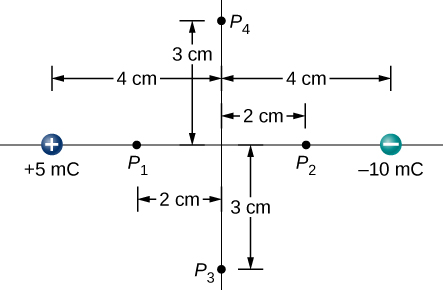| << Chapter < Page | Chapter >> Page > |
Check Your Understanding What is the potential on the axis of a nonuniform ring of charge, where the charge density is ?
It will be zero, as at all points on the axis, there are equal and opposite charges equidistant from the point of interest. Note that this distribution will, in fact, have a dipole moment.
Compare the electric dipole moments of charges separated by a distance d and charges separated by a distance d /2.
The second has 1/4 the dipole moment of the first.
Would Gauss’s law be helpful for determining the electric field of a dipole? Why?
In what region of space is the potential due to a uniformly charged sphere the same as that of a point charge? In what region does it differ from that of a point charge?
The region outside of the sphere will have a potential indistinguishable from a point charge; the interior of the sphere will have a different potential.
Can the potential of a nonuniformly charged sphere be the same as that of a point charge? Explain.
A 0.500-cm-diameter plastic sphere, used in a static electricity demonstration, has a uniformly distributed 40.0-pC charge on its surface. What is the potential near its surface?
How far from a point charge is the potential 100 V? At what distance is it
If the potential due to a point charge is at a distance of 15.0 m, what are the sign and magnitude of the charge?
;
The charge is positive because the potential is positive.
In nuclear fission, a nucleus splits roughly in half. (a) What is the potential from a fragment that has 46 protons in it? (b) What is the potential energy in MeV of a similarly charged fragment at this distance?
A research Van de Graaff generator has a 2.00-m-diameter metal sphere with a charge of 5.00 mC on it. (a) What is the potential near its surface? (b) At what distance from its center is the potential 1.00 MV? (c) An oxygen atom with three missing electrons is released near the Van de Graaff generator. What is its energy in MeV when the atom is at the distance found in part b?
a.
;
b.
;
c.
An electrostatic paint sprayer has a 0.200-m-diameter metal sphere at a potential of 25.0 kV that repels paint droplets onto a grounded object.
(a) What charge is on the sphere? (b) What charge must a 0.100-mg drop of paint have to arrive at the object with a speed of 10.0 m/s?
(a) What is the potential between two points situated 10 cm and 20 cm from a point charge? (b) To what location should the point at 20 cm be moved to increase this potential difference by a factor of two?
; a. Relative to origin, find the potential at each point and then calculate the difference.
;
b. To double the potential difference, move the point from 20 cm to infinity; the potential at 20 cm is halfway between zero and that at 10 cm.
Find the potential at points in the diagram due to the two given charges.

Two charges are separated by 4.0 cm on the z -axis symmetrically about origin, with the positive one uppermost. Two space points of interest are located 3.0 cm and 30 cm from origin at an angle with respect to the z -axis. Evaluate electric potentials at in two ways: (a) Using the exact formula for point charges, and (b) using the approximate dipole potential formula.
a.
and
;
b.
and
(a) Plot the potential of a uniformly charged 1-m rod with 1 C/m charge as a function of the perpendicular distance from the center. Draw your graph from . (b) On the same graph, plot the potential of a point charge with a 1-C charge at the origin. (c) Which potential is stronger near the rod? (d) What happens to the difference as the distance increases? Interpret your result.

Notification Switch
Would you like to follow the 'University physics volume 2' conversation and receive update notifications?